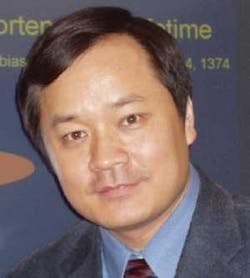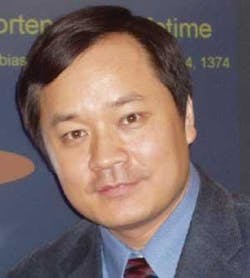Sunney Xie
By Barbara Goode
Many projects in my group were considered to be impossible only a few years ago,” says Xiaoliang “Sunney” Xie. So when considering a supposedly insurmountable challenge, “I ask my students to think not how it is impossible, but why it is impossible. We are so used to conventional wisdom that we don’t even ask why something is not possible; we are just told that it is so and we accept it as a fact.”
Xie, whose given name means “sunrise” in Chinese, is a professor of Chemistry in the Department of Chemistry and Chemical Biology at Harvard University, a post he has held for 10 years. This year marks the tenth anniversary of one of his best- known accomplishments, the development of coherent anti-Stokes Raman scattering (CARS) microscopy, which allows highly sensitive label-free imaging of molecular species based on their intrinsic vibrational frequencies.
In December 2008, his research group announced a successor to CARS: stimulated Raman scattering (SRS) microscopy. Just one month later, at BiOS/Photonics West 2009, several groups were reporting their own SRS results. “We’ve already used the technique to map the distribution of saturated and unsaturated lipids in a live cell, and to measure diffusion of medications in living tissues,” says Xie. These are just two early examples of how SRS microscopy can impact cell biology and medicine. As collaborator Jason Tsai of Pfizer puts it, “SRS’s impact has yet to be fully elucidated.”
Breaking through
Xie is fond of pointing out that it takes just as much work to make incremental progress as it does to make major advances. So, he asks, why not put your effort toward major goals? Lest any student or reader think that those who have made major achievements are endowed with greater gifts, Xie asserts, “It doesn’t take a genius to do something really creative. I’m not a genius, but I try to be a pioneer.” Of course, originality and hard work are needed, but according to Xie, the key is not being afraid of risks and bigger objectives.
“Take single-molecule spectroscopy at room temperature, for example,” he says, by way of explaining his approach. “It could have been done 20 years earlier, but nobody was thinking that way. I tell my graduate students that they should think that it is possible to do something like that.”
Xie enjoys teaching and working with students and postdocs. “I am deeply interested in fundamental science,” he says. “I think any breakthrough goes back to the basics … and teaching is very helpful in that regard.” Xie admits that while embracing risk is part of his nature, the process is not always compelling for students. Advances toward difficult goals sometimes takes years. He’s aware that asking a student or a postdoc to dedicate him- or herself to such work is asking a lot. So Xie doesn’t push. “People make contributions in different ways,” he says. But, he says, those who are not afraid of taking big risks get rewarded in the end. “It is a special experience for them. It is not easy the first time, but if they can do it once, they can do it again, and again. And the more one does it, the more exciting it becomes.”
Xie was born in Beijing in 1962. Following his childhood interests in electronics, physics, and chemistry (both his parents are chemists), he received his BS degree from Peking University and moved to the University of California, San Diego, where he earned his doctorate in chemistry as the second graduate student of John Simon, now vice-provost at Duke. Simon introduced Xie to ultrafast spectroscopy and its application to chemistry. “I had an idea to use time-resolved circular dichroism to study the conformational dynamics of proteins,” he says, “and John was extremely supportive. This work eventually became my Ph.D. thesis.” Simon wisely suggested that Xie do something different for his postdoctoral work. At the time, Xie says, “I was so naively attached to my “baby” that I thought I could never do anything better.”
He went on to the University of Chicago for postdoctoral work in the lab of Graham Fleming, a world leader in chemical physics and ultrafast spectroscopy, who is now vice-chancellor at UC Berkeley. There he was exposed to sensitive time-resolved fluorescent measurements and nonlinear spectroscopy, which prepared him for his later work.
After a short time at Chicago, Xie was offered the opportunity to interview with Pacific Northwest National Laboratory (PNNL). The lab’s site was highly polluted by Cold War–era plutonium production–but that led to a $250 million investment in a new laboratory for environmental science. One night, while thinking about his upcoming interview, he saw an article by Eric Betzig and colleagues at Bell Labs reporting on near-field optical microscopy. “At that time I was studying photosynthesis in Fleming’s lab, and I wanted to map out distributions of proteins in photosynthetic membranes,” he says. By then single-molecule spectroscopy had been carried out by W. E. Moerner and Michel Orrit, but their techniques worked only at cryogenic temperatures. Xie decided to try Betzig’s microscope to image single molecules at room temperature, which had the potential for biology applications. “That became my job proposal for PNNL,” he says. But, they weren’t looking for someone to do that–the field did not exist. PNNL invited him to come anyway, to do ultrafast spectroscopy, but said he could pursue the “single-molecule thing” in his spare time. So he moved there in 1992.
“I was so excited to pursue single-molecule imaging at room temperature,” he says. “But, first we had to learn near-field microscopy from Eric Betzig.” He worked day and night with his first postdoctoral fellow at PNNL, Bob Dunn. “We had a friendly race with Betzig as he had a similar goal.” Ultimately, Betzig won. In 1993, he reported the first single-molecule fluorescence image at room temperature using his microscope.
“Knowing Bob and I were disappointed, Steve Colson, the director of my research division, counseled us, ‘Why does it matter? It’s only a technique; there will be other techniques. What’s important is what you do with the technique.’” A few months after Betzig’s paper was published, Xie and Dunn published a paper in Science, simultaneously with a Los Alamos group, on probing single-molecule dynamics at room temperature. This work later won Dunn an academic position (he became a professor before Xie did). As Colson predicted, the near-field technique was superseded by far-field techniques, which offered easier single-molecule spectroscopy and imaging at room temperature.
Breaking in to bio
Once the technique matured, Xie decided to apply this tool to biophysics and enzymology. Xie and Peter Lu, another postdoctoral fellow at PNNL, published a paper in 1998 reporting real-time monitoring of stochastic biochemical reactions of a single enzyme molecule by fluorescence detection. This work proved to be a seminal contribution in the field of single-molecule enzymology, which is the basis of the single-molecule DNA sequencing technology that is currently being pursued by many research groups, including Xie’s, because of its potential societal impact. Shortly thereafter, the CARS microscopy work was published in collaboration with Andreas Zumbusch, a former postdoctoral fellow, and Gary Holtom, a PNNL colleague. The work used ultrafast lasers, but was again not what they originally hired Xie to do.
Xie notes that, by not starting in academia, his career path differed from many researchers. “I was interested in doing the most compelling science,” he says. “I was extremely fortunate to start my career at PNNL where I did not need to worry about funding. Doing cutting-edge research, one makes mistakes, and learns from mistakes, before succeeding in something innovative. It helps to have resources and a nurturing environment. My thanks to Steve Colson who gave us the freedom to pursue our own interests!” In retrospect, Xie does not think an academic setting would have enabled him to make the achievements he did while at PNNL. Once his work was known, people began to ask whether he would consider a move to academia. “When I went to PNNL, I really liked it there; I never considered it a stepping stone,” he says. “But I needed new challenges. In particular, I wanted to apply the single-molecule approach to biology in a more extensive way.”
He chose Harvard, where he was offered a tenured professorship. He immersed himself in learning molecular biology with his students. The move to Harvard coincided with the birth of Xie’s identical twin daughters. The biggest mystery of his life, he says, is how his daughters with identical genes have different characteristics.
To probe the secret of life in a living organism at the molecular level, his research group started to study gene expression using the single-molecule approach. In bacteria, there is only one copy of a gene in a cell. Consequently, the process of gene expression occurs in a stochastic fashion, and cannot be synchronized among different cells. Similarly, different cells with identical genes have different phenotypes. Xie believes that single-molecule experiments are essential in studying the fundamental biological process of gene expression.
After several years of repeated failure, in 2006 Xie’s group achieved the observation of the birth of single protein molecules in a living cell. They were the first to record real-time movies of protein production one molecule at a time in bacteria. This breakthrough, enabled quantitative description of gene expression. Last year, when Xie received the prestigious Berthold Leibinger Innovation Prize, the judges cited his outstanding contributions in applied laser technology, both CARS microscopy and single-molecule live-cell research.
“One great advantage about the American system,” he says, “is that young people get a lot of help.” Xie learned how to write effective grant proposals at Harvard. “I got all six grants the first time I applied for them. I just had to say, ‘this is one of my first proposals in academia.’” He quipped that his grants are sometimes turned down now.
He was chosen, in 2004, as one of nine winners of the inaugural NIH Director’s Pioneer Award, which netted a $500,000 discretionary fund each year for five years. This grant allowed the Xie research group to pursue its gene expression and CARS/SRS work, which would have been impossible through conventional funding.
With his Pioneer grant ending this year, funding is an ongoing challenge. However, Xie says that the NIH Pioneer award “has changed the way I do science,” making him focus on the big picture. “Of course, the big picture isn’t enough, I need to deliver! Fortunately, we did it this time. Now I continually think of exploratory work that has a potential of high return, with the inevitable high risk.”
He explains the evolution of his research. “I used to write papers in highly specialized fields that only a few people in the world would read,” he says. “When I started to do single-molecule spectroscopy, I found more people cared about our work. After we applied it to enzymology, and now having done single-molecule live-cell studies and SRS imaging, even more people are interested in our work. Gradually, I see our work begins to have an impact. This brings a lot of satisfaction to my students, to my research group, and to myself.”
And by the way, he says, “we’ve got this new idea. If it works, it will be transforming.”

